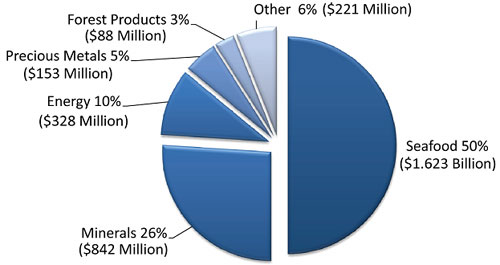 By LAINE WELCH March 06, 2010
"That's the question of the day," said one Kodiak halibut buyer. "It's hard to say how it will shake out," agreed Matt Moir, manager at Alaska Pacific Seafoods, one of Kodiak's largest processing plants. "The weather forecast is not good and frozen inventory is low, but the market won't sustain goofy prices. If it gets too high the market will shutdown." Talk on the waterfront pegged starting prices at Homer at around $5 a pound, but no word from elsewhere until deliveries start hitting the docks. Last year's starting prices were in the $3-$3.50 range, down more than a dollar from the previous two years. Halibut prices usually drop after the first month, when the market starts to settle out. Marketers expect about 4.5 million pounds of halibut will move to restaurants and supermarkets in the first month of fishing this year. Overall, there will be less of the big flatfish to go around during the eight month season the coast-wide catch of 50.6 million pounds is a 6.4% decrease from last year. That includes fisheries in British Columbia, the West Coast and Alaska. Alaska provides 80% of the North Pacific halibut harvest, and this year's catch limit is 42.3 million pounds, a drop of 3.3 million pounds from 2009. More than 2,100 Alaska longliners hold catch shares of halibut. Homer holds the title of the nation's #1 port for halibut deliveries, followed by Kodiak, Seward and major ports in Southeast. Dutch Harbor also ranks as one of Alaska's biggest ports for halibut landings. In fact, the largest halibut ever caught at 459 pounds was taken from Unalaska Bay. The sablefish (black cod) fishery also opens at the same time as halibut. Both fisheries end in mid-November. As a point of reference: the
average price paid to Alaska halibut fishermen in 2009 was $3.13/lb,
down from $3.70 in 2008. The dockside value of the halibut fishery
was $132 million, a drop of $43 million from 2008. For sablefish,
the average price in 2009 was $3.21/lb compared to $2.58 in 2008.
The value at the docks was $77 million, an increase of $8 million
from 2008. Fishermen are some of the best innovators that is demonstrated most recently in the Salmon Slide. It's a device designed for salmon gillnets that prevents the fish from being dropped on the hard deck. As the fish are picked from the net, the rubberized canvas Slide intercepts them, zips them into a cylinder mounted directly below and aft of the drum; then directs the salmon toward port or starboard fish holds. "When I first put it on the boat I could see the crew rolling their eyes and thinking this is just another one of my crazy things that will just be in the way and won't work. But from day one everyone went, 'Whoa, this really works'!" said Dave Hansen, a 30 year fishing veteran at Bristol Bay. Hansen invented the Salmon Slide after years of experimentation to find ways to improve fish quality. Originally, he just wanted to see if it would work for use on his own boat, the Eskimo Viking. It worked so well, Trident Seafoods put up funding for developing more. "I brought the initial demo to Trident and they could see that it was adaptable and could work," Hansen said. "They placed a large order and since then a few other processing companies have also. Now it's taking off." The Salmon Slide also made a big impression on Southeast gillnetters who focus on volumes of chum salmon, Hansen said. He believes it will work well on most fishing boats, and along with boosting fish quality, it also gives the crew a break. "It's much easier on the crew's hands. When six heavy fish come over the roller, that's basically 30 pounds on your fingertips that you're hanging onto as you're trying to pick one fish," he said. "Now they are supported and additionally, the firm canvas is right above the knee and they can lean into it. The Slide really helps keep your balance and makes it a lot easier to stand up on deck." Cost for the Salmon Slide is
about $1,200. Hansen said sales are now being made to processors
who turn them over to their fishing fleets. See a great video
on You Tube type in Salmon Slide. www.youtube.com The top winners in the 2010
Symphony of Seafood include Alaskan Amber Beer Battered Cod by
Trident Seafoods in the Foodservice category; Top Crusted Corn
Tortilla Salmon by Aqua Star in the Retail Category; and Wild
Alaskan Smoked Salmon Chowder by Ivar's Seafood in the Smoked
category. The grand prize, awarded to the product that received
the most overall votes, also went to Ivar's Smoked Salmon Chowder.
All winners get a free trip this month to the International
Boston Seafood Show. The Symphony of Seafood has been sponsored
by the Alaska Fisheries Development Foundation for 17 years.
www.afdf.org Seafood is by far Alaska's #1 export, although you wouldn't know it from the State press release where it was listed last! (see chart) Alaska's seafood exports were valued at $1.6 billion in 2009, down 9.8 percent. Japan remains the state's largest seafood export market, followed by China, Korea, Germany, the Netherlands and Canada. Next in line: zinc and lead
exports, valued at $784.7 million; liquefied natural gas at
&256.7 million (most has been shipped to Japan for more than
40 years); precious metals, mostly gold, at $152.6 million (nearly
all went to Switzerland); and refined petroleum products at
$38.4 million (down more than 70%). Coal exports were valued
at $33 million (up 42.8%). Most of Alaska's energy exports go
to Pacific Rim countries.  Source: U.S. Census Bureau February 2009 $3.3 Billion
|
||